Business
'Where does it stop?' Warehouse advance in Riverside County threatens rural lifestyle
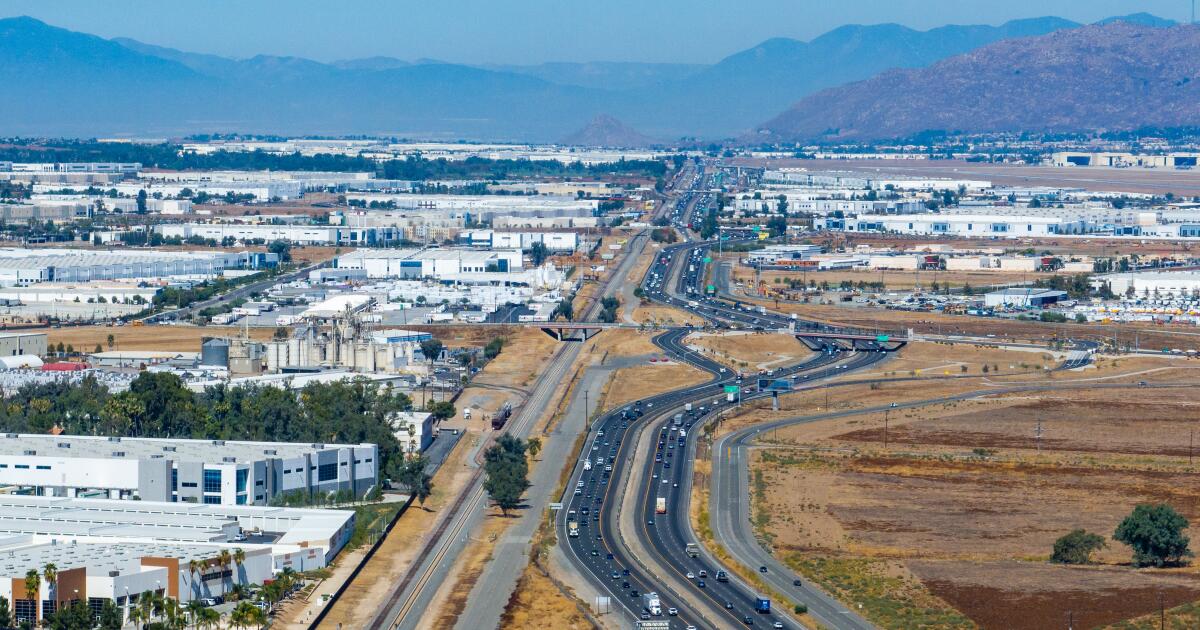
Seen from above, the industrial-scale warehouses straddling Interstate 215 where it intersects Mead Valley shimmer like a sprawling lake of white concrete boxes.
In this unincorporated Riverside County community, the big-box distribution hubs responsible for fulfilling online shopping orders have long been contained to a substantial strip west of the freeway. Burlington, Living Spaces and FedEx are among nearly 50 warehouse properties located here, capitalizing on Mead Valley’s easy access to rail and freeway corridors.
Beyond this strip, though, Mead Valley residents embrace a rural lifestyle. People here raise horses and livestock; most streets are lined with gravel trails, rather than sidewalks, to accommodate riders on horseback. Besides the new Farmer Boys restaurant near the freeway, the community has few local businesses other than gas stations, feed stores and plant nurseries.
As e-commerce exploded during the COVID pandemic, more distribution centers rose along the freeway, bringing more trucks to local roadways. Still, there was an understanding that, beyond the clearly delineated industrial zone, Mead Valley residents could maintain their solitude and sweeping views, in exchange for shouldering a disproportionate share of an industry critical to America’s online shopping habit.
But that sacred line in the dirt — where warehouse development ends and rural living begins — could soon be blurred.
Riverside County leaders are reviewing a dozen requests that would rezone portions of rural residential land in Mead Valley to create more space for industrial warehouses.
(Brian van der Brug / Los Angeles Times)
County leaders are reviewing a dozen requests that would rezone portions of rural residential land in Mead Valley to create more space for industrial use. Developers are seeking to expand warehouse development beyond the established industrial zone; at least one proposal would result in the demolition of dozens of homes as well as dedicated open space. Others would pierce the existing boundary, bringing the potential for warehouses and their 24/7 noise and exhaust to the outskirts of existing neighborhoods, fundamentally altering residents’ lifestyles.
County Supervisor Kevin Jeffries, who represents the district that includes Mead Valley, said he has “deep concerns” about the proposed changes. He described drawing a “big red rectangle” over Mead Valley’s industrial zone, indicating where he believed the boundaries of warehouse development should remain.
“All the low-hanging easy parcels for warehousing are pretty much all spoken for. And so the really big, deep-pockets developers now see opportunities to try and propose to go beyond the boundaries that have been put in place for decades,” said Jeffries, who is retiring after 12 years on the board.
“It’s going to be a challenge if they cross that line and start marching into what you might call Mead Valley proper. You start moving up that way — when or where does it stop?”
Resident Karla Cervantes expressed similar concerns. Cervantes and her husband, Franco Pacheco, raise their children and sheep on two acres in Mead Valley. She worries neighborhoods will start falling like dominoes as more rural residential land is rezoned for industrial use.
“Once one neighborhood is surrounded by warehouses, then the investors will come, buy them out, and then it creeps up more and more and more,” Cervantes said.
The county’s general plan amendment process, a largely bureaucratic zoning review the county undertakes every eight years, could prove pivotal for residents of Mead Valley this year: Will leaders green-light the proposed zoning changes, paving the way for more warehouses — and with them more jobs and revenue flowing into county coffers? Or is this the moment that the rapid-fire proliferation of distribution centers stretching for miles in each direction along the 215 corridor finally slows?
Riverside County’s unique rezoning process is the result of a more than two-decade-old settlement with the conservation group Endangered Habitats League, which sued the county in 2003 over concerns about sprawling development.
The settlement “resulted in a way to slow-roll development in the rural areas of the county,” said county planning director John Hildebrand.
Under terms of the settlement, developers who want to request zoning changes for swaths of land from one of five major uses to another — agriculture, open space, rural, rural community or community development — are able to request that change only every eight years, during the county’s Foundation General Plan Amendment cycle.
The process was designed to provide county leaders with the opportunity to take a comprehensive look at rezoning proposals, and “look at the bigger picture instead of piecemealing it,” said Dan Silver, executive director of the Endangered Habitats League.
Mead Valley, a majority Latino community of about 20,500 people, already has 2,000 square feet of warehouses per person, including existing and approved warehouses and those under environmental review, according to a data analysis by Susan Phillips, director of the Robert Redford Conservancy for Southern California Sustainability at Pitzer College, and Mike McCarthy, an adjunct professor and data scientist at the college.
That’s one of the highest warehouse-per-resident ratios in the Inland Empire, according to their analysis. And the rezoning applications that developers have submitted would add more than 1,000 additional acres of warehouse projects.
In preparation for their requests, many developers have already positioned themselves as “property owners” of large parcels by getting enough local homeowners to agree to sell their land, in exchange for sizable payouts, contingent upon the county’s approval of the zoning changes.
The Planning Commission has so far heard three zoning-change requests for District 1, which includes Mead Valley; several were continued to future meetings. If supervisors approve the requests, the developers must return to get approval for specific projects.

“It’s going to be a challenge if they cross that line and start marching into what you might call Mead Valley proper,” Supervisor Kevin Jeffries says of warehouse development.
(Brian van der Brug / Los Angeles Times)
One developer, Hillwood, is seeking a zoning change to build a million-square-foot warehouse, along with a public park, on about 65 acres of land just west of Mead Valley’s industrial corridor.
Currently known as the Cajalco Commerce Center, the proposed development would require the demolition of 26 homes and a commercial building. The developer has promised an estimated 974 jobs, as well as infrastructure improvements and landscaping along a main thoroughfare, according to the project’s draft environmental impact report. It would have a “significant and unavoidable” impact on air quality and transportation, the report said.
Paz Treviño lives on the outskirts of Mead Valley’s industrial corridor, on a two-acre lot where he sells heavy construction equipment. He has agreed to sell his property to Hillwood for $3 million, contingent on county approvals, he said. He has outgrown his current lot, he said, and with the money he stands to make from selling his land, he hopes to buy five or 10 acres elsewhere.
A member of Mead Valley’s Municipal Advisory Committee, he supports allowing more industrial development.
The warehouses, he said, bring jobs to a community where fewer than 8% of residents have a bachelor’s degree. He’s heard concerns about the lack of grocery stores, restaurants and healthcare facilities, and predicted those amenities would come as family incomes rise.
“We’re going to start getting the stores that people want,” he said. “But we’re not going to get those other industries — the food industries, the retail industries — without first having a stabilized middle class.”
He is frustrated with the anti-warehouse advocates trying to stand in the way of rezoning, and believes landowners such as himself should be able to profit handsomely from their investments. “It’s the landowners that have the last say, is what I say,” he said. “And if you’re not within the area, mind your damn business.”
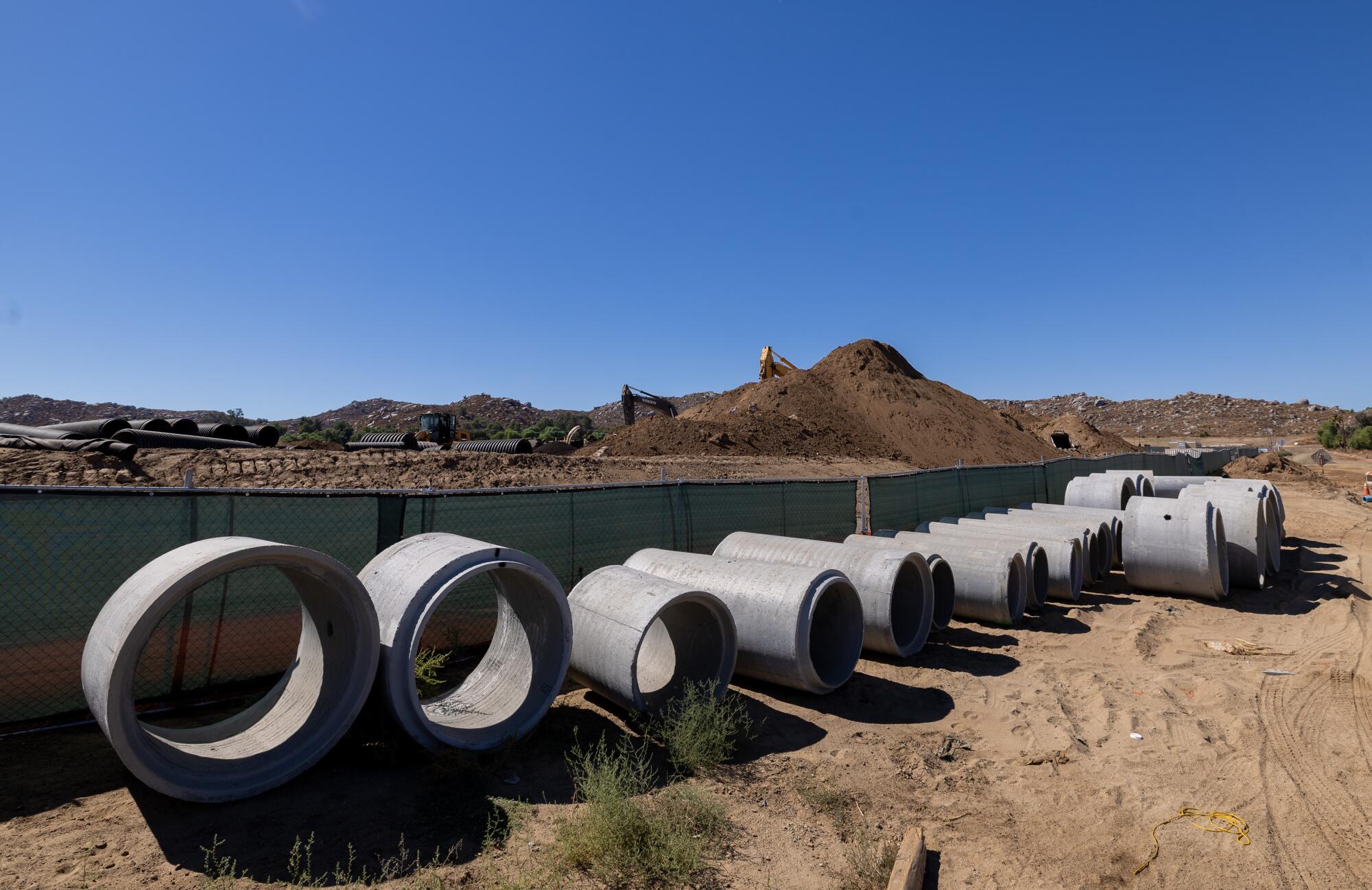
A warehouse development under construction in Mead Valley.
Shanowa De La Cruz could end up on the losing end of that equation.
De La Cruz, her wife and their children moved to a five-bedroom house on one acre in Mead Valley not far from Treviño’s property about three years ago. It was supposed to be their forever home, where they could raise their kids — five of six still live at home — as well as chickens, goats, ducks and a pig.
“We like our solitude. That’s why most of us live over here in Mead Valley,” De La Cruz said.
Six months after buying the property, they learned about the Cajalco Commerce Center proposal — and that some neighbors had already agreed to sell their properties to Hillwood. De La Cruz said she contacted the company and got an offer that barely covered what they paid for the home, presumably because the developer doesn’t need their property for the project.
The situation has left De La Cruz between a warehouse and a hard place: The developer would need to pay a “substantial” amount of money to get her family to move, she said. But if she stays and the proposal is approved, the development would loom nearby, infringing on their privacy and tanking their home value.
“It’s going to be one of those houses that is in between a warehouse” development, she said. “We’ve all seen those houses. No one’s going to buy that. You say, ‘Aw, pobrecito, they left them there.’”
Scott Morse, executive vice president with Hillwood, declined to comment on De La Cruz’s situation. He said the proposal has public support.
“We’re bringing something to the community that is needed and wanted by the community,” he said, “so that’s our compass.”
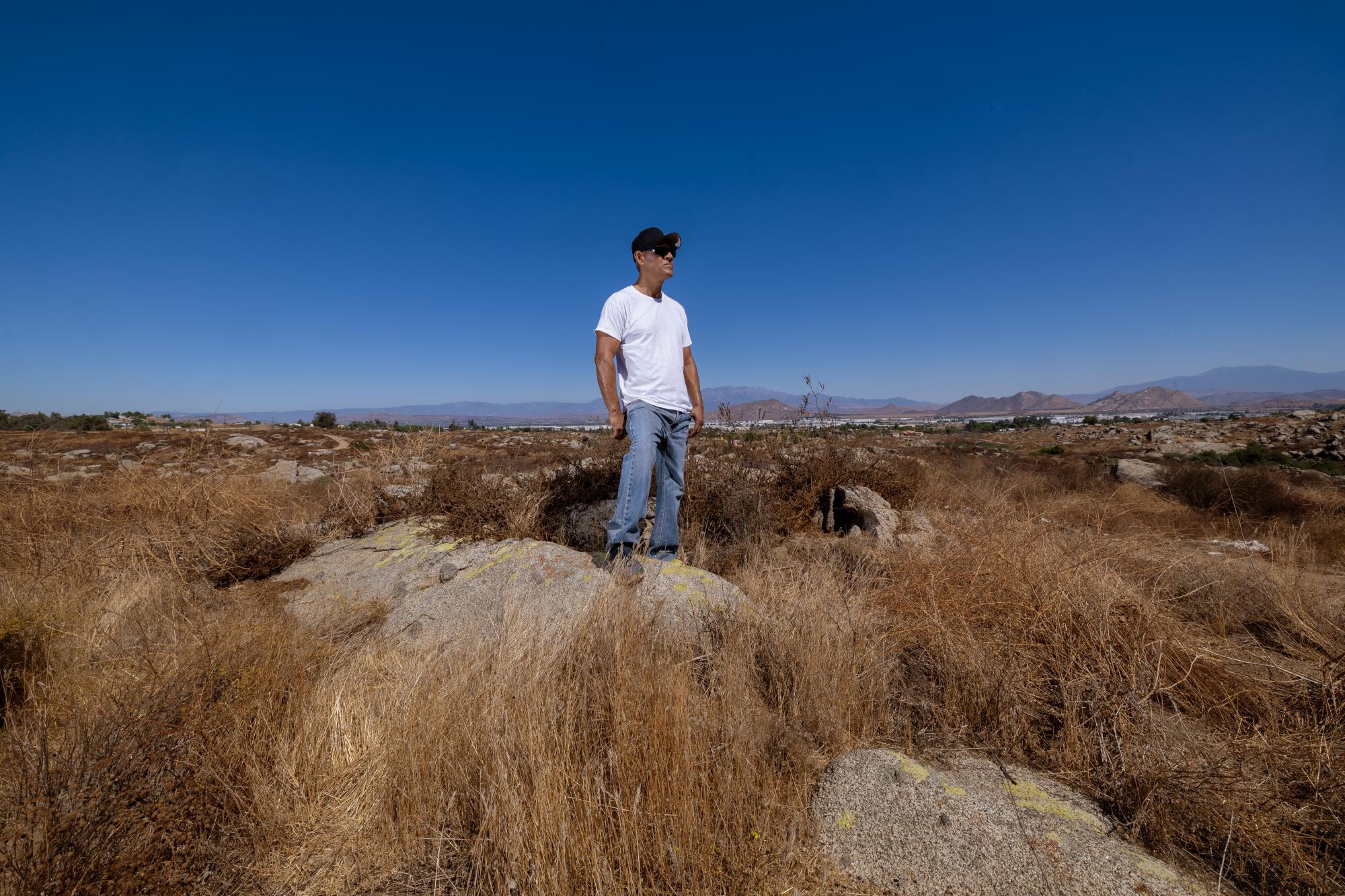
Mead Valley resident Raymond Torres says it’s “heartbreaking” to imagine the open space near his home converted for industrial development.
Raymond Torres moved away from the “hustle and bustle” of the San Diego area more than 20 years ago and eventually built two homes on a quiet street in Mead Valley.
Standing in his driveway on a clear day, he can see the San Jacinto and San Gabriel ranges, and Big Bear and Palomar mountains. Across the street from his property is open space, where he says he regularly sees owls and kangaroo rats among the grasses and native plants. His neighbors ride horses on the land; he prefers to traverse it on wheels — by dirt bike, quad or go-kart.
The property directly across the street from him is not proposed for rezoning, but a large swath of open land surrounding it is. The real estate and investment firm Deca has proposed rezoning 648.5 gross acres from rural residential to community development, with a mix of residential, commercial and industrial components, according to Travis Duncan, Deca’s vice president of development.
“Additionally, we intend to set aside a substantial portion of the property as open space and are excited about the mix of commerce and conservation that the project offers,” Duncan said.
Torres said it’s “heartbreaking” to imagine the land being used for development.
“It’s our neighborhood,” he said. “We have pride in it.”
The Deca proposal would also bring industrial development much closer to the home of Cervantes and Pacheco. Their two-lane street already has become a truck bypass. They are concerned warehouses will beget warehouses, eventually ending up in their backyard.
Mead Valley is oversaturated with warehouses and semis, they argue, and yet the community itself remains underinvested. Mead Valley would look “amazing” if it was actually benefiting from major portions of the revenue that industrial development is generating for Riverside County, Cervantes jokes. Pacheco notes that the closest Target — on the other side of the freeway — is not a retail store but a massive distribution center.
Earlier this year, Pacheco and Cervantes launched the Mead Valley Coalition for Clean Air to oppose warehouse expansion. They see the rezoning fight as a fight for Mead Valley’s future. For the residents who stay, the question is whether county leaders will rubber-stamp continued expansion of the I-215 industrial corridor, and whether that line in the dirt — between industrial and rural residential — will survive.
But Cervantes said trying to keep Mead Valley from drowning in the shimmering sea of white warehouses often feels like an uphill battle. She worries about a future with worse air quality and decreased property values, and about the limited opportunities for young people growing up amid a mass logistics hub.
“When they look to see the sun rise,” she said, “they’re going to see the sun rise on a bunch of warehouses.”
This article is part of The Times’ equity reporting initiative, funded by the James Irvine Foundation, exploring the challenges facing low-income workers and the efforts being made to address California’s economic divide.

Business
Contributor: A Trump deregulator may set us up for a sequel to the 2008 crisis

The movie “The Big Short” — dramatizing the reckless behavior in the banking and mortgage industries that contributed to the 2008 financial crisis — captures much of Wall Street’s misconduct but overlooks a central player in the collapse: the federal government, specifically through Fannie Mae and Freddie Mac.
These two government-created and government-sponsored enterprises encouraged lenders to issue risky home loans by effectively making taxpayers co-sign the mortgages. This setup incentivized dangerous lending practices that inflated the housing bubble, eventually leading to catastrophic economic consequences.
Another critical but overlooked factor in the collapse was the Community Reinvestment Act. This federal law was intended to combat discriminatory lending practices but instead created substantial market distortions by pressuring banks to extend loans to borrowers who might otherwise have been deemed too risky. Under threat of regulatory penalties, banks significantly loosened lending standards — again, inflating the housing bubble.
After the bubble inevitably burst, Fannie and Freddie were placed under conservatorship by the Federal Housing Finance Agency. The conservatorship imposed rules aimed at preventing future taxpayer-funded bailouts and protecting the economy from government-fueled market distortions.
Now, President Trump’s appointee to lead that agency, Bill Pulte, is considering ending this conservatorship without addressing the core structural flaw that fueled the problem in the first place: implicit government guarantees backing all Fannie and Freddie mortgages. If Pulte proceeds without implementing real reform, taxpayers on Main Street are once again likely to be exposed to significant financial risks as they are conscripted into subsidizing lucrative deals for Wall Street.
Without genuine reform, the incentives and practices that led to the crisis remain unchanged, setting the stage for a repeat disaster.
Pulte’s proposal isn’t likely to unleash free-market policies. Instead, it could further rig the market in favor of hedge funds holding substantial stakes in Fannie and Freddie, allowing them to profit enormously from the potential upside, while leaving taxpayers to bear all the downside risks.
A meaningful solution requires Fannie and Freddie to significantly strengthen their capital reserves. The two government-sponsored enterprises still remain dangerously undercapitalized. A report from JP Morgan Chase describes it this way: “Despite steady growth in [their net worth], the GSEs remain well below the minimum regulatory capital framework requirements set by the Federal Housing Finance Agency in 2020.” Imposing robust capital requirements similar to those that govern private banks would oblige the two enterprises to internalize their risks, promoting genuine market discipline and accountability.
Further reforms should address transparency and oversight. Enhanced disclosure standards would allow investors, regulators and the public to better assess risks. Additionally, limiting the types of mortgages these entities can guarantee could reduce exposure to the riskiest loans, further protecting taxpayers. Implementing clear rules that prevent Fannie and Freddie from venturing into speculative financial products would also mitigate potential market distortions.
Critically, the federal government must clearly communicate that future bailouts are not an option. Explicitly removing government guarantees would compel Fannie and Freddie to operate responsibly, knowing that reckless behavior will lead to their insolvency, not to another taxpayer rescue. Clear legal separation from government backing is essential to prevent moral hazard.
The combination of government guarantees, regulatory pressure from policies such as the Community Reinvestment Act and inadequate capital standards created the perfect storm for the 2008 financial crisis. Ignoring these lessons and repeating past mistakes would inevitably lead to a similar disaster.
Proponents of prematurely releasing Fannie and Freddie argue that market conditions have changed and risk management has improved. Yet, history repeatedly demonstrates that without structural changes, financial entities — particularly those shielded by government guarantees — inevitably revert to risky behavior when market pressures and profit incentives align. Markets function best when participants bear the full consequences of their decisions, something impossible under the current structure of these government-sponsored enterprises.
Ultimately, the only responsible approach is removing taxpayers from the equation entirely. Fannie Mae and Freddie Mac should participate in the mortgage market only as fully private entities, without any implicit government guarantees.
The American public doesn’t need a sequel to “The Big Short.” The painful lessons of the 2008 crisis are too recent and too severe to be ignored or forgotten. Market discipline, fiscal responsibility and genuine reform — not government-backed risk-taking — must guide our approach going forward. We can only hope that the Trump administration chooses fiscal responsibility over risky experiments that history has already shown end in disaster.
Veronique de Rugy is a senior research fellow at the Mercatus Center at George Mason University. This article was produced in collaboration with Creators Syndicate.
Business
Palisades Village to reopen with Elyse Walker rebuilding flagship store

Elyse Walker made a bet in 1999: that residents of Pacific Palisades and Brentwood would rather shop for designer fashions in their neighborhood than drive to Beverly Hills.
Her eponymous boutique, initially just 800 square feet, became the cornerstone of a retail empire that now stretches from Tribeca to Newport Beach, drawing celebrities such as Jennifer Garner and Kate Hudson. It also propelled a renewal of downtown Palisades, with new restaurants and boutiques moving in.
That all changed on Jan. 7, when the Palisades fire leveled Walker’s flagship store and thousands of homes and other businesses.
A man rides a scooter past a burning business in Palisades Village on Jan. 8.
(Brian van der Brug / Los Angeles Times)
On Wednesday, Walker proudly announced her next bet on the neighborhood where she raised her two sons.
In downtown Palisades, she and developer Rick Caruso revealed that Caruso’s Palisades Village shopping center will reopen in mid-2026 and that her flagship store, elysewalker, will become its newest marquee tenant.
“I hope that this serves as the catalyst for other retailers and brands and big businesses and small businesses to come back to the Palisades, Malibu, Altadena and Pasadena,” Walker said in an interview. “Twenty-five years ago, we planted seeds in this community, and now we are doing it again.”
Caruso told The Times that later this year, he plans to resume the Palisades Village annual Christmas tree and menorah lighting. He said he will also underwrite the cost of new landscaping and sidewalks in the streets around the shopping center.
The goal, he said, is to create a visible anchor to a town in the midst of a massive recovery and to accelerate the return of a vibrant, bustling community.
“This is a really big deal,” Caruso said. “When a retailer like Elyse opens a store in a community, that’s a powerful voice of confidence that there’s a bright future here. I really do believe with her and our organization, the rebirth of the Palisades is going to be unstoppable.”
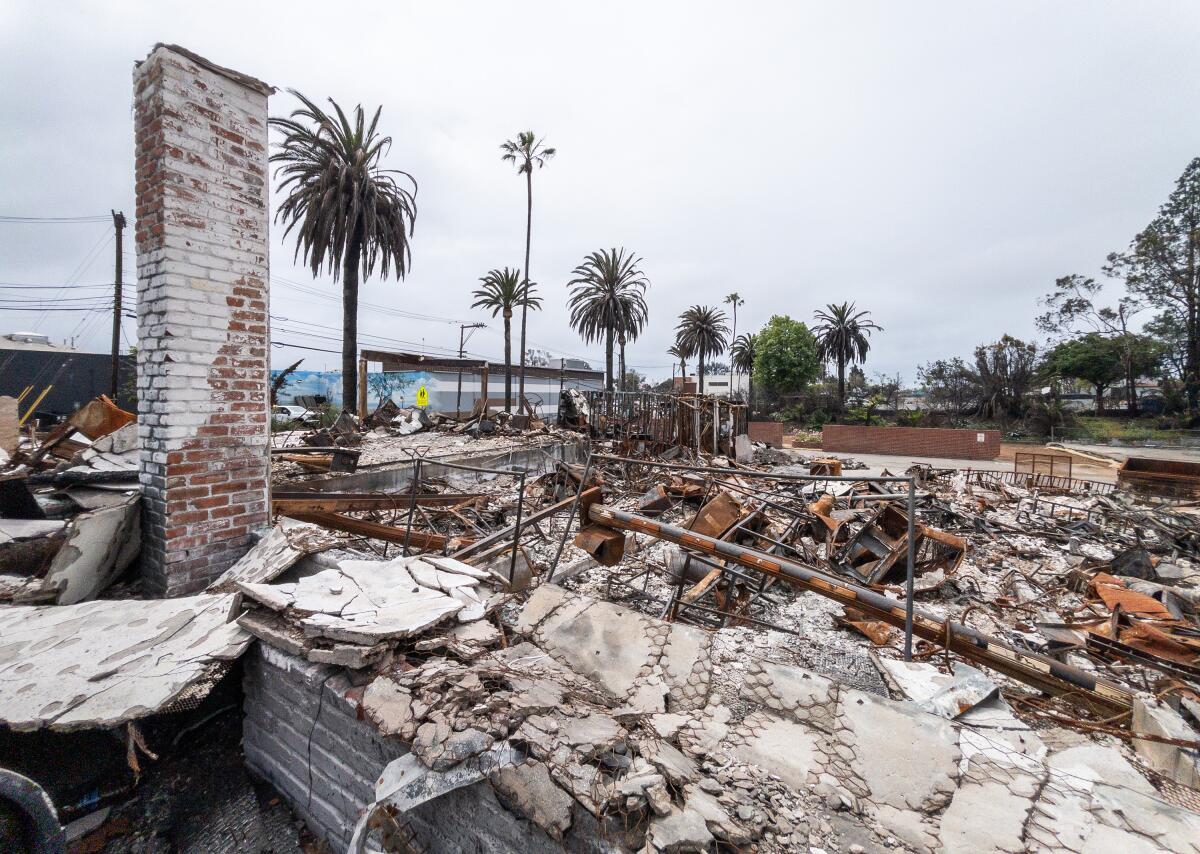
The location of Fashion designer Elyse Walker’s former flagship store in Pacific Palisades that was destroyed in the Palisades fire on Jan. 7.
(Myung J. Chun/Los Angeles Times)
The news came during a frustrating and uncertain period as Palisades residents recover from the devastation of the wildfire and grapple with the mass displacement of their community. Thousands have relocated to disparate parts of Southern California or are scattered across the U.S.
“The fact that we have this hub in the middle of town is a ray of hope that we can get back sooner,” said Chris Feil, a Palisades native who moved six times after the fire before settling in a rental in Manhattan Beach. His wife, Mia Feil, said she gets emotional thinking of what was lost in the blaze. The couple is now in the early stages of rebuilding.
“We’re all sort of traumatized by the loss of our community,” she said, listing the impromptu gathering at restaurants, Saturday baseball games, the annual Christmas tree lighting and the Fourth of July parade. “Having all those things back is truly the lifeline and joy in the neighborhood — that’s what makes the Palisades so special. It’s a small town in a big city.”
Walker chose to open her shop on Antioch Street more than 25 years ago so that she could easily walk to her sons’ school.
“We were between three churches, two coffee shops and five schools — it had nothing to do with co-tenancy yet,” Walker said. “We just knew this was a place where people would be walking around.”
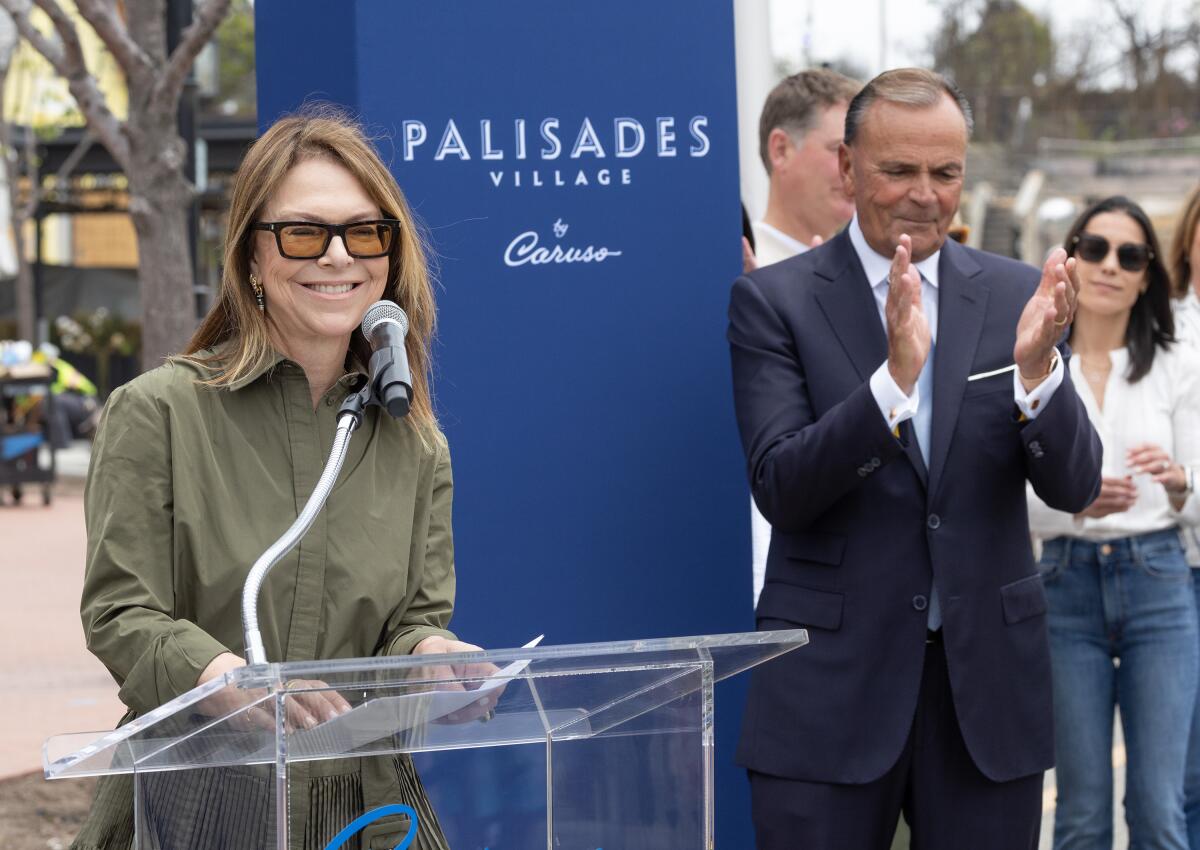
Fashion designer Elyse Walker said she trusts Rick Caruso, right, as she announced the reopening of her flagship store at the Palisades Village on Wednesday.
(Myung J. Chun/Los Angeles Times)
Her shop drew well-heeled women from across the region, and she expanded the store’s footprint six times, reaching nearly 6,500 square feet. Her store generated $5,000 per square foot in sales — among the highest in American multi-brand retail. She developed a team of private shoppers and stylists that visited clients in their homes for curated fashions.
Along the way, Walker became an ambassador of sorts to would-be retailers and business owners in the Palisades, such as Cafe Vida, Lemon Nails and Caruso’s Palisades Village, which opened in 2018 and brought a movie theater, Erewhon and Chanel.
“People who live in the Palisades don’t want to leave. It’s a magical place — they nestle into the mountains right by the ocean,” Walker said.
On Jan. 7, Caruso relied on a fleet of private firefighters to prevent the flames from destroying Palisades Village and some nearby properties.
But Walker’s shop was reduced to rubble, the merchandise incinerated by the inferno.
The store had about 30 employees, and Walker said she has been in “sink or swim mode,” trying to keep her staff employed, serve local customers through her shops in Calabasas and Newport Beach and trudge through the arduous task of dealing with insurance.
“The first thing I said to my team: there’s no four walls that can define me, and there’s no four walls that define the magic,” she said.
She recalled the couples who met in the store, the women who learned they were pregnant there, and the local resident whose 3-year-old son had died and who needed a dress for the funeral.
“So much happened in the dressing room of that store, and none of that is gone — those relationships and friendships and trust are still there,” Walker said.
With Walker’s shop opening inside Palisades Village in the spring or summer of 2026, and with new trees, streetscapes and upgraded sidewalks coming to the downtown, Caruso said he hopes the area will be a cradle of redevelopment and a beacon for those vacillating about rebuilding.
“Hopefully, that spurs other landlords to invest in their buildings and spurs other retailers to open up,” he said. “We’re going to be roaring back and before you know it, it’s going to be full of families. These neighborhoods are going to flourish.”
Business
Six Flags to cut 135 jobs at Knott’s, Magic Mountain and other California parks

Six Flags Entertainment Corp. has laid off the presidents of Knott’s Berry Farm and Six Flags Magic Mountain and will cut scores of other jobs in California as part of a major shake-up at the theme park giant.
The company, which operates 42 amusement parks across North America, plans to reduce its staff by 10% in the coming weeks. The cuts will include the president positions at many of its parks, Six Flags spokesperson Sara Gorgon said Tuesday.
In all, the company will eliminate about 135 jobs across its California parks by the end of June. The California parks include Knott’s in Buena Park, Magic Mountain in Valencia, Six Flags Discovery Kingdom in Vallejo and California’s Great America in Santa Clara.
The cost-cutting follows last year’s $8-billion merger of Six Flags with Cedar Fair, making it the largest amusement park operator in North America.
The cuts come during a challenging period for Six Flags and others in the tourism business. The company posted a net loss of $220 million in the first quarter of this year, citing weather variability and economic uncertainty.
State and local tourism officials are projecting a slowdown in travel to California due to Trump’s trade war and deportation policies.
Additionally, smaller theme park operators such as Six Flags struggle to compete with bigger industry players Disney and Universal, which also boast more diverse portfolios with streaming and other media.
The Orange County Register first reported that Knott’s President Jon Storbeck and Magic Mountain President Jeff Harris were among those affected by the layoffs.
Storbeck served as vice president of Disneyland before he joined Knott’s in 2016. Harris had held multiple positions at Six Flags before taking over the president role at Magic Mountain in 2023.
The Charlotte, N.C.-based company said the changes reflect its move toward a regional operating structure, rather than individual parks having their own presidents. Some park presidents will be absorbed into other roles at the company, Gorgon said.
In an earnings call earlier this month, Six Flags Chief Executive Richard Zimmerman had warned the company would significantly restructure and pare down its workforce this year. He said the company remained “firmly on track” to achieve its goal of $120 million in reduced expenses by the end of the year.
Former Cedar Fair CEO Matt Ouimet, who previously led Disneyland, lamented what he called a “parade of departures” from Six Flags in a post on LinkedIn last week. Ouimet said he had chosen to retire before having to vote on the merger because he feared the fallout.
“I recognized that I wasn’t up to watching talented colleagues being asked to exit in order to achieve the cost synergies that were promised to investors,” Ouimet wrote. “This die was cast when the merger agreement was signed.”
Also this month, Six Flags announced it would close its theme park and Hurricane Harbor water park in Bowie, Md., after the 2025 operating season.
Six Flag shares closed at $35.06, up nearly 3% on Tuesday.
-

 Culture1 week ago
Culture1 week agoDo You Know the English Novels That Inspired These Movies and TV Shows?
-

 Education1 week ago
Education1 week agoVideo: Columbia University President Is Booed at Commencement Ceremony
-

 Education1 week ago
Education1 week agoHow Usher Writes a Commencement Speech
-
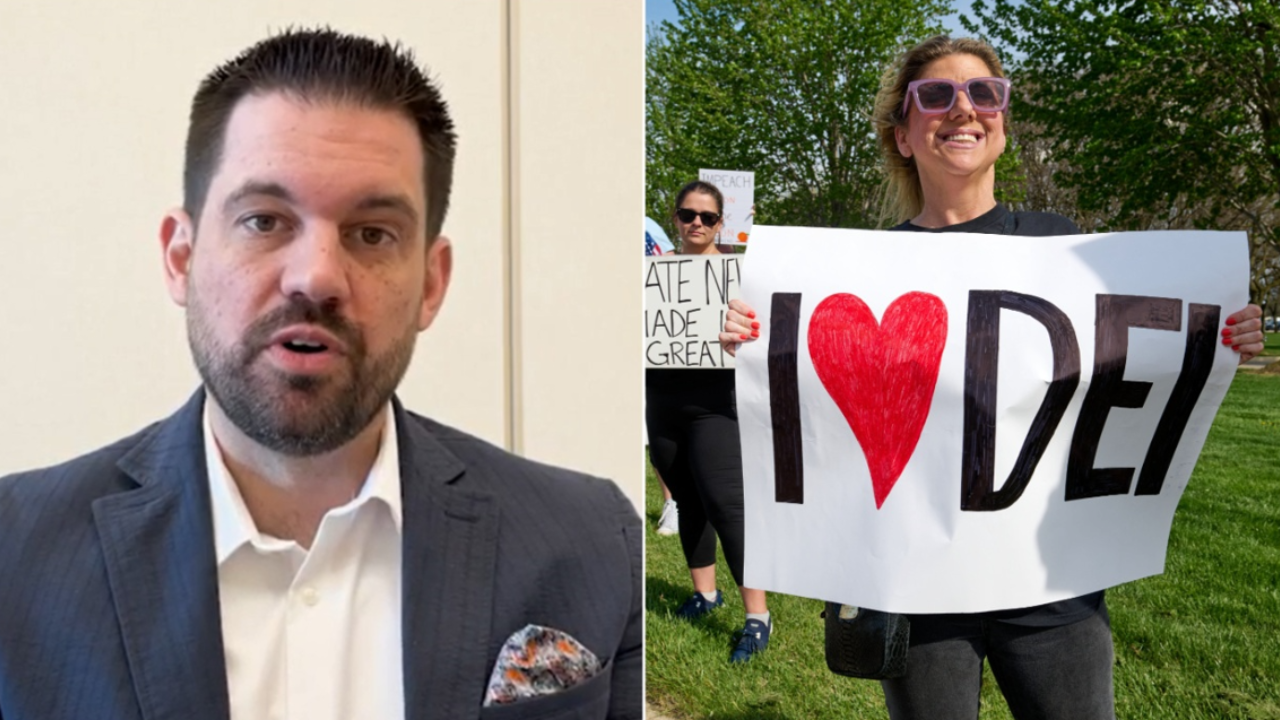
 Politics1 week ago
Politics1 week agoExpert reveals how companies are rebranding 'toxic' DEI policies to skirt Trump-era bans: 'New wrapper'
-

 World1 week ago
World1 week agoEU reaches initial deal to lift economic sanctions on Syria: Reports
-

 Technology1 week ago
Technology1 week agoAMD’s new RX 9060 XT looks set to challenge Nvidia’s RTX 5060
-

 News1 week ago
News1 week agoRead the Full ‘Make America Healthy Again’ Report
-

 News1 week ago
News1 week ago'Golden Dome' Missile Shield To Be 1st US Weapon In Space. All About It















